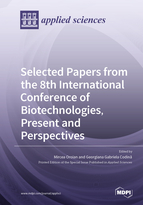Selected Papers from the 8th International Conference of Biotechnologies, Present and Perspectives
A special issue of Applied Sciences (ISSN 2076-3417). This special issue belongs to the section "Food Science and Technology".
Deadline for manuscript submissions: closed (15 June 2022) | Viewed by 39323
Special Issue Editors
Interests: food rheology; food authentication and adulteration detection; development of new methods for food characterization
Special Issues, Collections and Topics in MDPI journals
Interests: cereal products; rheological properties; sensory analysis; functional foods
Special Issues, Collections and Topics in MDPI journals
Special Issue Information
Dear Colleagues,
The 8th International Conference of Biotechnologies, Present and Perspectives (https://fia-old.usv.ro/fiajournal/conference2021/) organized by Ştefan cel Mare University, Faculty of Food Engineering, Suceava, Romania, is an excellent opportunity for experts, researchers, staff, and enthusiasts in the Food, Agri, and Biotech fields from around the world to share the latest advancements and future trends in biotechnologies from the food industry, applied engineering sciences, food product quality, food safety, environment protection, and equipment for the food industry.
Papers published in the Special Issue “Selected Papers from the 8th International Conference of Biotechnologies, Present and Perspectives” will be focused on recent advances in food biotechnology, applied engineering sciences, food safety and technology, ecology and environmental engineering, food quality, and equipment for the food industry.
Prof. Dr. Mircea Oroian
Prof. Dr. Georgiana Gabriela Codină
Guest Editors
Manuscript Submission Information
Manuscripts should be submitted online at www.mdpi.com by registering and logging in to this website. Once you are registered, click here to go to the submission form. Manuscripts can be submitted until the deadline. All submissions that pass pre-check are peer-reviewed. Accepted papers will be published continuously in the journal (as soon as accepted) and will be listed together on the special issue website. Research articles, review articles as well as short communications are invited. For planned papers, a title and short abstract (about 100 words) can be sent to the Editorial Office for announcement on this website.
Submitted manuscripts should not have been published previously, nor be under consideration for publication elsewhere (except conference proceedings papers). All manuscripts are thoroughly refereed through a single-blind peer-review process. A guide for authors and other relevant information for submission of manuscripts is available on the Instructions for Authors page. Applied Sciences is an international peer-reviewed open access semimonthly journal published by MDPI.
Please visit the Instructions for Authors page before submitting a manuscript. The Article Processing Charge (APC) for publication in this open access journal is 2400 CHF (Swiss Francs). Submitted papers should be well formatted and use good English. Authors may use MDPI's English editing service prior to publication or during author revisions.
Keywords
- food biotechnology
- food quality
- food safety
- food analysis
- applied engineering sciences
- ecology and environmental engineering
- equipment for the food industry







